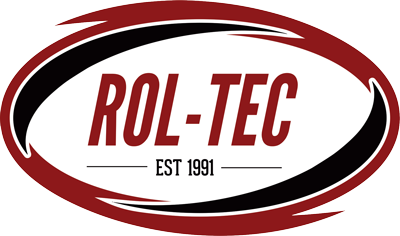Cast Urethane / Polyurethane Rollers
Urethane in the roller and molding industry is most often a liquid that is cast in molds to produce parts or roller covers. We do not use millable urethanes because their physical properties are not near what cast urethane can accomplish or what properties engineers are specifying when “urethane” is requested. In general, millable urethanes are used by covering companies that do not have the capability to supply true liquid cast urethane.
Characteristics
Cast urethanes are compounded using one of two base urethane materials, ester urethane or ether urethane. Esters and ethers can be further broken down into two subcategories, TDI (toluene di-isocyanate) and MDI (methylene diphenyl di-isocyanate). TDI’s are typically cured with MOCA (MBOCA) while MDI’s are typically cured with TMP’s. Depending on what physical properties are required, other curatives can be used to offer peak performance of the final urethane component. The formulation can be manipulated to achieve the true physical properties required by the engineer for the desired part or roller. For example, other additives can be combined with the cast urethane formulations to enhance desirable characteristics such as improved or reduced coefficient of friction. A wide range of durometer can be accomplished from 20 Shore A to 70 Shore D as well as different tensile strengths, oil resistance, or compression sets depending upon the urethane formulation.
Benefits of Polyurethane Rollers Include:
- Improved Abrasion Resistance
- Cut Resistance
- Higher bond strength
- Non-Marking Materials among many others
Limitations of polyurethane include early failure in high-temperature service, moist hot environments, and when exposed to certain chemicals.
Polyurethane Molded Part Applications:
For polyurethane molded part applications, formulations can be made that will provide several advantages versus metal machined parts. These advantages include low-cost repeatability, lighter weight, and often longer wear than metal.
Urethane Common Names:
- Polyurethane
- PU
- CU
Ask us if we have a cast urethane formulation to improve your roller cover or molded part.
Cast Urethane vs. Millable Urethane Properties:
We use Nitrile as a baseline rubber guide in this chart.
Rubber Compound |
Nitrile | TDI Ester Urethane |
MDI Ester Urethane |
TDI Ether Urethane |
MDI Ether Urethane |
Millable Urethane |
| BN | ESUT | ESUM | ETUT | ETUM | MU | |
| Physical Properties | ||||||
| Hardness Range Shore A | 20-95 | 20-110 | 85-95 | 20-110 | 40-95 | 40-95 |
| Hardness Range P&J | 370-0 | 370-0 | 30-13 | 370-0 | 200-13 | 200-13 |
| Abrasion Resistance | 3 | 5 | 5 | 3 | 4 | 2 |
| Tear Resistance | 3 | 5 | 5 | 4 | 4 | 3 |
| Load Bearing | 4 | 4 | 3 | 5 | 5 | 2 |
| Hysteresis | 2 | 2 | 2 | 3 | 3 | 4 |
| Resistance to Denting | 3 | 5 | 3 | 5 | 3 | 3 |
| Maximum Service Temperature (C/F) | 121/250 | 105/220 | 105/220 | 105/220 | 105/220 | 100/175 |
| Ozone Resistance | 1 | 5 | 5 | 5 | 5 | 2 |
| Resiliency | 3 | 5 | 5 | 4 | 4 | 2 |
| Solvent Resistance | ||||||
| Acids | 2 | 1 | 1 | 4 | 4 | 1 |
| Caustics | 3 | 5 | 5 | 1 | 1 | 1 |
| Paraffinic Hydrocarbons | 5 | 5 | 5 | 2 | 2 | 2 |
| Aromatic Hydrocarbons | 3 | 3 | 3 | 3 | 3 | 1 |
| Chlorinated Hydrocarbons | 1 | 3 | 3 | 3 | 3 | 1 |
| Water | 4 | 1 | 1 | 4 | 4 | 2 |
| Ketones | 2 | 3 | 3 | 3 | 3 | 1 |
| Alcohols | 5 | 3 | 3 | 3 | 3 | 2 |
| Esters | 1 | 1 | 1 | 4 | 4 | 1 |
| Recommended Applications | ||||||
| Coating/Varnishing | ● | |||||
| Embossing | ||||||
| Flexography | ● | |||||
| Laminating | ● | ● | ● | |||
| Laser Engraving | ||||||
| Metal Decorating | ● | ● | ||||
| Offset Printing | ||||||
| Paper Making Industry | ● | ● | ● | ● | ● | |
| Plastics | ||||||
| Plate Processors | ● | |||||
| Steel Mill Rollers | ● | ● | ● | ● | ● | ● |
| Textile Rollers | ● | |||||
| Wood Industry | ● | ● |



